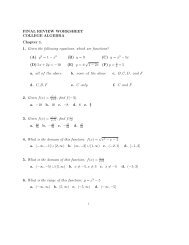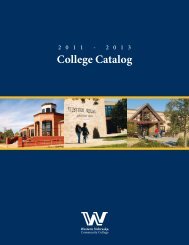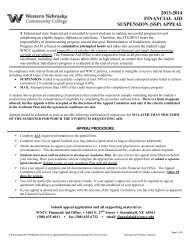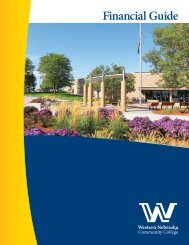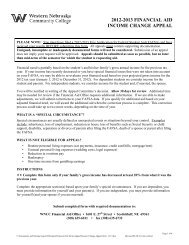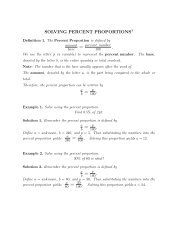WNCC 2010 Self-Study Report - Western Nebraska Community ...
WNCC 2010 Self-Study Report - Western Nebraska Community ...
WNCC 2010 Self-Study Report - Western Nebraska Community ...
Create successful ePaper yourself
Turn your PDF publications into a flip-book with our unique Google optimized e-Paper software.
After receiving the survey results early in the fall term of 2007, members of the Student Learning<br />
Committee held several informal discussion sessions to which faculty members and students were<br />
invited. The Student Learning and Assessment Coordinator and the Dean of Educational Services<br />
also hosted meetings at Sidney and Alliance, along with three different ones at Scottsbluff. At the<br />
sessions, the results were examined, and each participant got a copy of the benchmark results.<br />
CCFSSE Survey<br />
At the survey result discussion meetings, gaps in student achievement or opportunities for<br />
improvement were considered. Instructors were asked to compare overall student responses with<br />
their own internal practices for questions related to instructional activities. In other words,<br />
instructors could recognize certain questions that tied most directly to activities or assignments in<br />
their courses, so they were encouraged to look at the overall results to understand how their<br />
students may have responded, and from there to explore ways in which they could improve the<br />
learning in their classes by adding, modifying, or enhancing instruction.<br />
During the same sessions, certain differences between student and faculty perceptions were also<br />
noted, using such questions, for instance, as how often students are required to do a presentation.<br />
Faculty members (combined full- and part-time responses) reported that students made<br />
presentations in their classes very often at 10%, while students reported only at the rate of 4%. On<br />
the question of how often students contributed to class discussions, 51% of the faculty responded<br />
“Very Often,” although only 26% of the students surveyed believed that to be the case (RR 70).<br />
Considering differences in responses for cases like the examples above led to discussions about<br />
student perception and the degree of interaction in the class, as well as the degree to which<br />
students recognized their active role in the learning process. Consequently, an element was<br />
added to the Educational Services Strategic Plan with the goal to “Revise questions on the student<br />
survey form and implement a new version with Class Climate system” to gather more data in<br />
general as well as to get data keyed to the learning process rather than environmental factors.<br />
As discussed elsewhere, the Division of Language and Arts decided as a group to increase<br />
presentation opportunities within its course offerings, and the math instructors standardized<br />
assessment projects and began to incorporate them into all the courses in the algebra sequence,<br />
not only using the instruments for data collection but calling attention to them as explicit<br />
assessment tools so that students realize that assessment of their learning is taking place.<br />
Another instance where CCSSE information influenced the Strategic Plan for Educational Services<br />
is reflected in the area of teaching oversight, where the strategy was to “Focus on instructor<br />
evaluation guidelines for adjunct faculty members, especially to support new faculty.” This change<br />
arose from disparities in responses between the full-time and part-time faculty estimations of the<br />
degree to which the student engagement strategies highlighted in the survey were utilized (the selfreported<br />
practice rate for part-time instructors being considerably lower).<br />
Building on the idea of consistency and quality as key tenets of the CCSSE survey, plans were<br />
outlined in the strategic plan for online instruction to “Adopt best practices model for online classes”<br />
and to “Standardize creation, delivery methods, and site design expectations for online courses”<br />
(RR 71).<br />
Page 104<br />
<strong>Western</strong> <strong>Nebraska</strong> <strong>Community</strong> College



